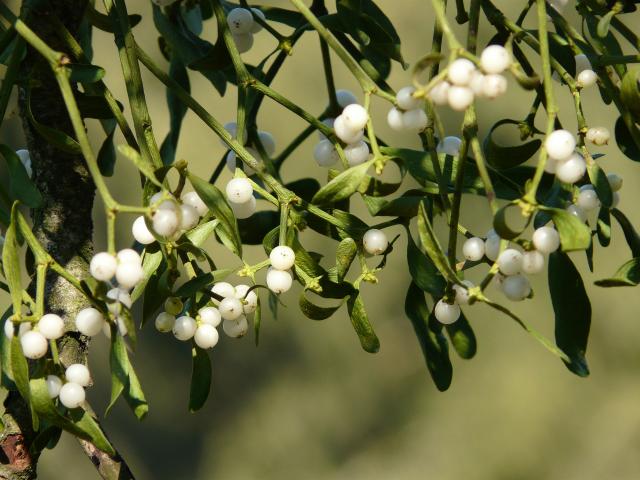Traditionally, Mistletoe is hung above a door frame at Christmas and a berry removed with each kiss underneath it.
If you do indulge in a bout of seasonal snogging under the Mistletoe this year, you might want to consider saving the berries and attempting to grow your own. This will not only aid your future quest for smooching but could also support a rare moth – the Mistletoe Marble.
European Mistletoe Viscum album is an evergreen, parasitic plant which grows mainly on trees. As a partial parasite, Mistletoe makes some of its own food but also takes minerals from its host tree.
It is mostly found in the damp border country between England and Wales and especially in counties such as Herefordshire, Worcestershire, Gloucestershire, Gwent and Somerset. It often occurs on apple trees in orchards there.
The main hosts are trees such as apple, lime, hawthorn, poplar, field maple, elm, sycamore and ash. Mistletoe also grows on plants such as False Acacia, Japonica, Cotoneaster and Laburnum. Despite needing trees, Mistletoe is not generally a woodland plant preferring hosts in open situations such as orchards, gardens, parkland and hedgerows.

If you want to try and grow Mistletoe in your garden there are three possible methods: placing the seeds under the bark of trees, grafting, or smearing the sticky seeds onto branches. The latter is recommended and mirrors the natural way that birds such as the Mistle Thrush and Blackcap spread the seeds after eating the berries - they are either excreted or rubbed off the beak onto tree branches.
The best time to try applying the seeds onto a suitable tree branch is February or March. Berries from Mistletoe cut at Christmas can be kept by removing them from the plant and storing in a shed, but it is better to obtain fresh ones if possible. Mistletoe has separate berryless male and berried female plants so you will need to grow many seeds to ensure that you have berries for Christmas kisses.
 Gardeners in the Severn valley. Welsh borders and southwards might be able to tempt the rare Mistletoe Marble moth Celypha woodiana into their gardens. Mistletoe is the foodplant for its caterpillars, which mine into the leaves and overwinter there, exiting to pupate in June, with adults flying in July and August.
Gardeners in the Severn valley. Welsh borders and southwards might be able to tempt the rare Mistletoe Marble moth Celypha woodiana into their gardens. Mistletoe is the foodplant for its caterpillars, which mine into the leaves and overwinter there, exiting to pupate in June, with adults flying in July and August.
For detailed advice about how to grow mistletoe visit The Mistletoe Pages website
Happy Gardening!
The BC Towers ‘Secret Gardener’


